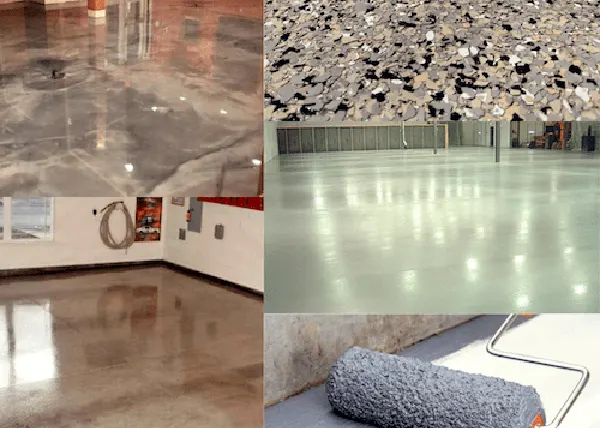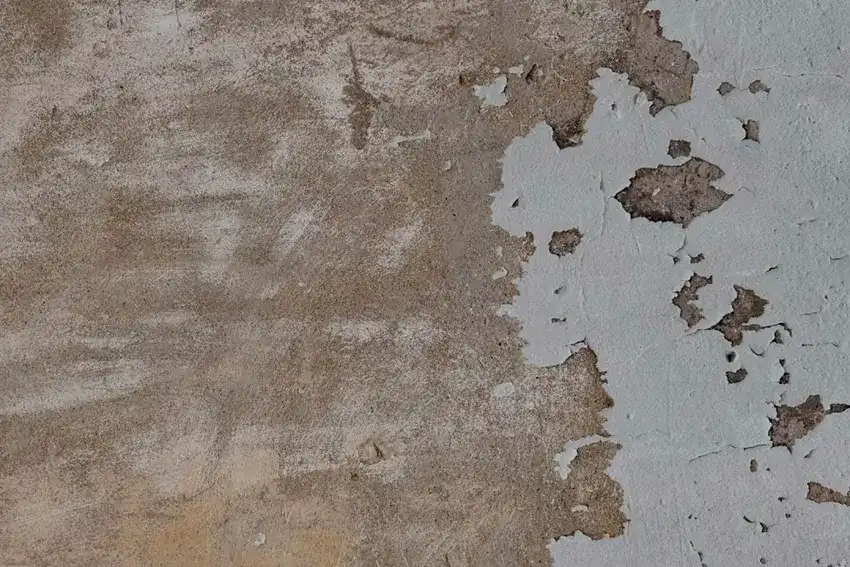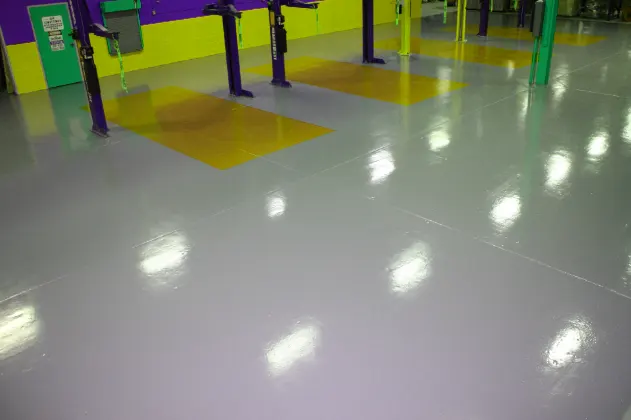Concrete cement paint may seem like a simple type of coatings, but it’s actually more complex than it appears. If you want to know what concrete cement paint is, explore the various types, and make a choice that meets the needs of your current project, you’ve come to the right place. Whether you’re a homeowner looking to refinish your driveway or a contractor looking for the best product for your client, it can be helpful to know which concrete paint to choose and how to use it correctly. Are you ready? Follow us and start your journey into the world of concrete cement paint.
What is concrete cement paint?
Concrete cement paint is a specially formulated paint designed to adhere to concrete and cement surfaces. Unlike regular paint, it is made with a unique blend of acrylic or epoxy resins, pigments, and cement that allows it to effectively bond with the porous nature of concrete. This not only gives concrete surfaces a new look and enhances the surface’s aesthetics, but also provides protection against weathering, moisture, and wear and tear.

What is concrete cement paint
Why Use Concrete Cement Paint?
Due to the porous and rough texture of concrete, traditional paints often have difficulty adhering and can peel or crack over time. However, concrete cement paint is specifically formulated to meet these challenges. It penetrates deep into the cement surface to form a strong bond that can withstand the elements, making it ideal for both indoor and outdoor applications. For more information on how to apply cement paint to concrete and the preliminary preparations, please visit our corresponding blog.
When it comes to painting concrete surfaces, concrete cement paint offers many advantages over traditional paints. These product features make this specialty cement paint a top choice for these applications.
- Superior Durability: Concrete cement paint is formulated to withstand the unique challenges that concrete surfaces present. It is highly resistant to chipping, flaking, and cracking, even under heavy foot traffic or extreme weather conditions. This makes it ideal for high-traffic areas such as driveways, sidewalks, and commercial floors.
- Moisture and Weatherproof: Concrete cement paint is able to act as a moisture barrier. By sealing the porous surface of concrete, it helps prevent water from penetrating, thereby preventing cracks, mold growth, and structural damage. This protective layer ensures that your concrete surface remains intact and beautiful for a long time.
- Multiple Finish Options: Whether you want a smooth, shiny finish or a more textured look, concrete cement paint is available in a variety of finishes and colors, allowing you to transform dull concrete into something visually appealing and unique. . This versatility allows you to customize your concrete surface to your aesthetic preferences, whether it’s a sleek modern patio or a rustic garden path.
- Easy to Maintain:Once applied, concrete cement paint makes it easy to maintain your surface. Its smooth, sealed surface repels dirt, dust, and stains, making it easier to clean. This not only saves time, but also keeps your space looking fresh and vibrant with minimal effort.
Concrete cement paint isn’t just for one specific type of project. Its unique properties make it widely used in residential projects and commercial spaces.
- Outdoor Patios and Driveways:Want to give your patio or driveway a fresh new look? Concrete cement paint can transform drab, gray concrete into a vibrant, welcoming space. It’s perfect for creating custom patterns, borders, and even mimicking the look of more expensive materials like stone or tile. Plus, its durability ensures the finish can withstand the elements and the wear and tear of pedestrians and vehicles.
- Garage and Basement Floors: The environment in these spaces is characterized by moisture and high wear. Applying concrete cement paint can help enhance the look of these spaces and also provide a protective barrier against stains and damage. This is especially useful in garages, where oil and other automotive fluids can easily stain uncoated concrete.
- Commercial and Industrial Spaces:In environments like warehouses, factories, or workshops, concrete cement paint is a durable, low-maintenance flooring solution. It can withstand the erosion of heavy machinery, frequent traffic, and a variety of chemicals while providing a clean, professional look.
- Pools and Water Features:For areas that are frequently exposed to water, concrete cement paint offers excellent water-resistant properties. It can be used to line pools, fountains, or other water features, protecting concrete from water damage and providing a smooth, attractive finish that enhances the overall aesthetic of your space.
Concrete cement paint is more than just a coating – it’s a smart investment in the longevity and appearance of concrete surfaces. The versatility of concrete cement paint allows it to be used almost anywhere concrete is found. Click here to learn how to renovate cement floor at low cost. Whether you’re looking to improve the exterior of your home or ensure the functionality of a commercial space, this paint offers a practical and effective solution. If you’re looking to add color, protect concrete surfaces from the elements, and extend their life, concrete cement paint is a strong choice.
What types of concrete paint are there?
When it comes to painting concrete, not just any polymer coating will do. Choosing the right type of paint for your project is crucial, as different formulations offer unique benefits and limitations. Painting a concrete slab with the wrong coating can increase its risk of cracking and peeling. Concrete coatings come in a variety of polymer types, each designed to meet specific needs and conditions. The main types include acrylic latex paints, epoxy paints, polyurethane coatings, and polyurea coatings. Each coating has unique properties that make it suitable for different applications.

Cement Cement Coating Types
- Acrylic Latex Paint:Acrylic latex paint is the most convenient and versatile and affordable option. It is water-based, easy to apply, available in a wide range of colors, and designed to conceal imperfections and resist fading. This type of paint is ideal for interior surfaces, such as basements and walls, where high durability is not a primary consideration. It is also breathable, meaning it allows moisture to escape from the concrete, reducing the risk of peeling and cracking.
- Epoxy Paint:Epoxy paint is the top choice for heavy-duty applications. It forms a tough resin surface that is resistant to chemicals, stains, and abrasion, making it ideal for garage floors and commercial spaces. However, it requires more preparation and skill, as the two-component formula must be mixed before application. The result is a smooth, high-gloss finish that is both beautiful and functional.
- Polyurethane Coatings:Polyurethane coatings are known for their flexibility and resistance to UV light, which helps prevent yellowing and degradation over time. These coatings are often used in outdoor environments like driveways and patios, where exposure to sunlight is a concern. While they offer excellent durability and a high-gloss finish, they can be more expensive and require professional application for best results.
- Polyurea Coatings:Polyurea coatings are the premium choice for high-performance concrete protection. They provide superior resistance to chemicals, abrasion, and extreme temperatures, making them ideal for industrial settings and areas exposed to harsh conditions. The rapid curing time of polyurea coatings is both an advantage and a challenge; while it allows for quick turnaround, it requires precise application techniques and equipment.
| Comparison of Concrete Paint Types | |||
|---|---|---|---|
| Type | Advantages | Disadvantages | Best Use |
| Acrylic Latex Paint | Easy to apply, quick drying, affordable, breathable | Less durable, not suitable for high-traffic areas | Interior walls, low-traffic concrete surfaces |
| Epoxy Paint | Highly durable, chemical and stain resistant, attractive finish | Requires extensive surface prep, can be tricky to apply | Garage floors, commercial spaces, high-traffic areas |
| Polyurethane Coatings | UV resistant, flexible, long-lasting | Higher cost, professional application recommended | Outdoor surfaces, driveways, patios |
| Polyurea Coatings | Extreme durability, rapid curing, resistant to harsh conditions | Expensive, requires specialized application equipment | Industrial floors, areas with high chemical exposure |
To achieve a more suitable coating effect in different application environments, concrete porch and patio coatings are usually low-gloss acrylic latex paints designed to cover imperfections and prevent fading, wear, cracking and UV damage. Epoxy-based coatings are highly durable and stain-resistant, making them ideal for garage or patio floors. For industrial and high-demand environments, polyurea coatings have unparalleled performance.
Understanding these options can not only help you achieve the best results, but also ensure that your investment in concrete coating pays off in the long run. Choosing the right type of coating can significantly improve the appearance and life of the concrete surface. We will explain more in detail in the following content.
5 common questions about concrete cement paint.
When it comes to concrete coatings, a smooth, flawless finish is often what we as applicators aim for. But achieving that goal can come with some challenges, and issues like unevenness, cracking, flaking, bubbling, and fading can make an otherwise simple task daunting. Here are some of the most common questions about concrete cement coatings that CoatingsDirectory has compiled from past experience, along with professional insights and practical solutions to ensure your project is a success.

Common Questions about Concrete Cement Paints
Paint Cracking on Concrete
Caused by the natural movement of the concrete substrate. Concrete expands and contracts with changes in temperature and humidity, which can cause stress cracking on the painted surface. It is usually recommended to choose paints with high elasticity, such as acrylic latex or polyurethane paints, which can accommodate slight movements in the substrate without cracking.
Paint Peeling off Concrete
Peeling can be caused by poor adhesion between the paint and concrete surface due to inadequate concrete surface preparation, the presence of moisture, or the use of the wrong type of paint. Before painting, always make sure the concrete surface is thoroughly clean and dry. Apply a suitable primer to enhance adhesion, and choose a paint specifically formulated for concrete.
Bubbling on Concrete Paint
Blistering occurs when moisture trapped under the paint layer tries to escape. This is usually caused by painting on a damp surface or applying thick paint too quickly. Always test the concrete for moisture before painting. Apply paint thinly and evenly, and allow adequate drying time between coats to prevent moisture buildup.
Uneven coverage of concrete paint
Poor painting techniques, using inferior tools or not stirring the paint thoroughly can lead to uneven paint thickness and color coverage. Generally, the applicator uses a high-quality roller or brush to ensure that the paint is thoroughly mixed before painting to avoid this. Professional applicators can apply paint with consistent and even strokes to achieve uniform coverage. You can use our online platform to find a local on-site applicator near you.
Concrete paint fading
Fading is a common problem, especially on outdoor concrete surfaces exposed to sunlight and adverse weather conditions. UV rays can damage the pigments in the paint, causing the color to fade over time. It is recommended that you choose a paint with UV resistance, such as polyurethane or epoxy paint, and consider applying a UV-resistant clear coat for added protection.
How to choose the right concrete cement coating?
After reading the above, I believe you have a clear understanding of the different types of concrete coatings. But with so many options, choosing the perfect concrete cement coating for your project can be overwhelming. Choosing the right concrete cement coating is not only for aesthetics, but also to ensure the longevity, durability and functionality of the surface. There are several key factors to consider when choosing a coating, including surface type, usage scenario, weather conditions and durability requirements. By carefully evaluating these aspects, you can avoid common pitfalls and choose a coating that meets your expectations.

Choosing Concrete Cement Paint
- Concrete surface condition:Different concrete surfaces have unique characteristics that influence the type of coating required. Smooth, polished concrete, for example, may require an epoxy primer to ensure proper adhesion, while rough, porous surfaces may benefit from a thicker, high-build coating like polyurea. The surface’s condition is also critical—cracks, moisture levels, and previous coatings must be addressed before application.
- Usage Scenario:The intended use of the surface is another critical consideration. For residential settings like patios and driveways, coatings that provide moderate durability and aesthetic appeal, such as acrylic latex or polyurethane, are typically sufficient. In contrast, high-traffic areas like commercial garages or workshops require more robust options like epoxy or polyurea coatings, which offer greater resistance to abrasion, chemicals, and heavy machinery.
- Weather Conditions: Environmental factors can significantly impact the performance and longevity of concrete coatings. In regions with extreme temperatures or high UV exposure, coatings with good thermal stability and UV resistance, such as polyurethane or polyurea, are essential to prevent cracking, peeling, and discoloration. Additionally, moisture levels should be considered—high humidity or water exposure can cause certain coatings to fail, making moisture-resistant options like epoxy ideal for these conditions.
- Durability Requirements:Understanding the level of durability required for your project will help narrow down your choices. If your surface is exposed to heavy impacts, such as a factory floor or a warehouse, a coating with high tensile strength and impact resistance, like polyurea, is necessary. For less demanding environments, a less robust but easier-to-apply option like acrylic latex may be more appropriate.
- Application and Maintenance: Ease of application and maintenance is another important factor to consider. Some coatings, such as epoxy, require meticulous surface preparation and a multi-step application process, while others, like acrylic latex, are more user-friendly and can be applied with minimal preparation. Additionally, consider the maintenance requirements; high-gloss finishes, for example, may require regular cleaning to maintain their appearance.
Choosing the right concrete cement coating can transform your project from a temporary fix to a long-term investment. By considering the concrete surface condition, intended use, environmental conditions, and durability requirements, we can confidently make the right choice to meet expectations. The right coating product can not only protect and beautify your concrete surface, but also extend the life of your building. How long is the service life of concrete coatings? Please follow us to continue reading.
How Long Does Concrete Paint Last?
- Type of Paint:Different paints have varying durability levels. Epoxy and polyurethane coatings are known for their exceptional longevity and resistance to harsh conditions, whereas acrylic latex is more susceptible to wear and may need more frequent reapplication.
- Surface Preparation:Proper surface preparation is critical for ensuring strong adhesion and long-lasting results. Surfaces should be clean, dry, and free from cracks or imperfections before painting. Poor preparation can lead to premature peeling and chipping.
- Environmental Conditions: Weather conditions and exposure to elements such as UV rays, moisture, and extreme temperatures can significantly impact paint durability. For outdoor surfaces, choosing a paint with UV resistance and waterproof properties is essential.
- Usage and Traffic: The level of traffic and type of use can affect how long the paint lasts. High-traffic areas like driveways and garage floors experience more wear and tear compared to patios or decorative concrete surfaces.
- Maintenance: Regular maintenance, such as cleaning and minor touch-ups, can extend the life of concrete paint. Neglecting maintenance can lead to a shorter lifespan, as dirt and debris can wear down the coating over time.
| Average Lifespan of Different Concrete Paints | ||
|---|---|---|
| Concrete Paint Type | Application Scenario | Average Lifespan |
| Acrylic Latex | Indoor walls, decorative surfaces | 2-5 years |
| Epoxy | Garage floors, industrial spaces | 5-10 years |
| Polyurethane | Driveways, outdoor patios | 7-10 years |
| Polyurea | Heavy-duty commercial use | 10+ years |
| Elastomeric | Waterproofing, exterior walls | 5-7 years |
Tips for Prolonging the Life of Concrete Paint.
Of course, we can also delay the life of concrete coatings as much as possible by mastering some maintenance and maintenance tips.- Proper Surface Preparation: Always ensure the surface is thoroughly cleaned and free of cracks or previous coatings that could interfere with adhesion.
- Choose High-Quality Paint:Investing in high-quality paint like epoxy or polyurea can significantly extend the lifespan of your coating, reducing the need for frequent reapplications.
- Apply a Primer:Using a primer suited to your chosen paint type can enhance adhesion and provide a better foundation for the topcoat, increasing durability.
- Seal the Surface:For exterior applications, applying a sealer can provide an extra layer of protection against moisture, UV rays, and temperature fluctuations.
- Regular Maintenance:Keep the painted surface clean and perform touch-ups as needed to prevent small issues from becoming larger problems.
- Reapply as Needed:Even the best paint will eventually wear out. Monitoring high-traffic areas and scheduling periodic reapplications can help maintain the appearance and functionality of your surfaces.
In summary, choosing the right concrete cement paint obviously requires understanding your project requirements and the characteristics of the paint. We’ve introduced the various types, answered common questions, and provided insights to achieve lasting results. Now that you have knowledge of the different types of concrete cement paint, you’re also confident that you have optimized methods to avoid some common painting problems. For those looking for specific products or professional services, be sure to use the search function on coatingsdirectory.com. Whether you’re looking for a reliable supplier or a local contractor who specializes in concrete coatings, our directory provides you with everything you need to get started.
Can you paint directly on concrete?
Yes, you can paint directly on concrete, but there’s a catch! While it might be tempting to skip the prep work, proper surface preparation is essential for the paint to adhere well and last longer. Before painting, the concrete must be clean, dry, and free of dust, grease, or old coatings. For best results, consider using a concrete primer to enhance adhesion and durability. This step ensures the paint bonds effectively, reducing the chances of peeling and chipping down the road. So, while it’s possible, a little extra prep work goes a long way in ensuring a beautiful and lasting finish.
How to paint a concrete floor without sanding it?
It’s possible to paint a concrete floor without sanding, but only if the surface is already smooth and clean. Start by thoroughly cleaning the floor to remove any dirt, grease, or debris. Next, use an etching solution designed for concrete to create a rough texture, which helps the paint stick better. After rinsing and allowing the floor to dry completely, apply a concrete bonding primer before painting. This method eliminates the need for sanding and still ensures a strong bond between the paint and the concrete surface. Remember, a well-prepped floor is key to a long-lasting paint job! Whenever possible, it is highly recommended that you sand the concrete surface to achieve a more durable coating.
Which polymer paint is the best concrete paint?
Epoxy paint is often considered the gold standard for concrete surfaces. Its durability, chemical resistance, and ability to withstand heavy traffic make it ideal for garages, basements, and commercial spaces. Polyurethane and polyurea paints are also excellent choices, offering similar durability with added flexibility, making them perfect for outdoor areas. When choosing the best polymer paint, consider the specific needs of your project, such as exposure to chemicals or heavy use, to select the most suitable option. Each type has its unique strengths, but for most indoor applications, epoxy is hard to beat!
Does concrete cement paint resist chemicals and stains?
Absolutely! High-quality concrete coatings, especially epoxy and polyurethane coatings, are resistant to water, chemicals, abrasion, and UV rays. This makes them ideal for garages, workshops, and industrial spaces where spills and stains are common. They form a durable, non-porous surface that prevents things like oil, grease, and chemicals from penetrating the concrete. While most concrete coatings offer some degree of resistance, it’s critical to choose a product specifically designed for high chemical exposure if this is a major concern for your space. Always check the specifications of the coating to ensure it meets your needs.

